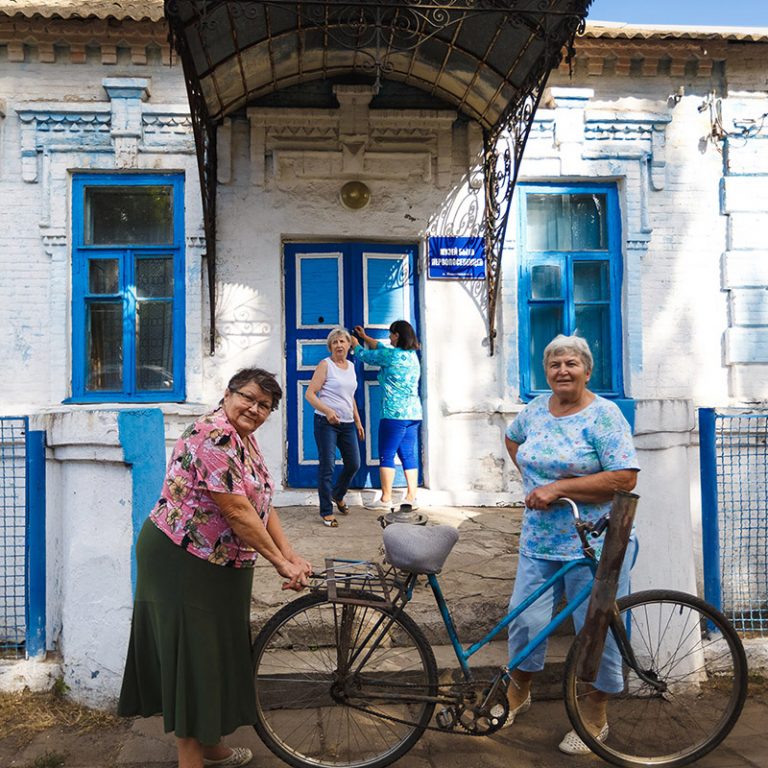Old Believers or some would say schimastics began to settle in Ukrainian land with the beginning of the reformation of the Russian Orthodox Church in the XVIIth century. They interpreted Christianity differently and had a number of denominations, which gradually gained hundreds of thousands of followers. In Ukraine, the most widespread communities of Old Believers are the Lipovans and Molokans. The Molokan community arose in the 18th century in the Tambov and Vladimir provinces of the Russian Empire. In the 1820s and 30s, the first Molokans left, and the rest were already forcibly removed from their native lands to Pryazovia, near the Sea of Azov, where they founded a number of settlements and live compactly to this day.
Molokans are those who use verbal ‘milk’, that is, read the Holy Scriptures. This is how they explain the name of their spiritual Christian community — the word for ‘milk’ in Russian is Moloko — which appeared in the Tambov and Vladimir provinces of the Russian Empire in the 17th century. Then emperor Peter I limited the power of the Orthodox Church and created a Synod (council — tr.) of bishops, which controlled the clergy. The weakening of the church’s influence gave people the opportunity to read and interpret the Bible by themselves. Various interpretations of the Holy Scriptures caused the emergence of new spiritual communities — whips, eunuchs, Molokans, Dukhobors, Sabbath-keepers, and so on. Thus, the Russian Empire unintentionally recreated the Western European Reformation for itself.
It was the year 1823. The Orthodox Church was negative towards the nearly formed Christian communities, which renounced traditional church sacraments, such as baptism and communion, and did not recognise the church hierarchy and icons. During the reign of Russian emperor Alexander I, who was a supporter of religious freedom, the Molokans were able to leave (in fact — escape) to the lands of the then Tavria province (now — Pryazovia, the Azov region). There, they built new Molokan settlements, without fear of the condemning views of the Russian clergy. And in a couple years — in 1825 — the new emperor Nicholas I forcibly sent the Molokans to the south of modern Ukraine, which was back then still sparsely populated, so that their religious doctrine did not spread throughout the empire.
Molokan families stopped at a swampy place, where the other Old Believers, the Dukhobors, resided before. They also rejected the traditional church, and instead of the Bible, studied a collection of psalms and stories called the Book of Life, put together by their community leaders.
In Pryazovia, the Molokans founded the village of Novovasylivka, named after the first settler and head of the local Molokan community, Vasily Chernov. Since then, they have been actively building the village, moving there with large families, building a school and a house for traditional Sunday spiritual gatherings.

Novovasylivka. Old-Timers
Descendants of the old Molokan families preserve the history of Novovasylivka in detail. In addition to the family of Vasilii Chiernov, the figure of Vasilii Mazaiev, who also became famous outside his native village, often appears in the memories of the local old-timers. He is known for his sheep breeding and for the sheep breed, known to the rest of the world as the ‘Mazayevskaya merino’.
Vasilii Mazaiev left behind a building, which had served as a house of prayer for the Molokan community since 1860, and during the Soviet times became a club and later a premises for the party district committee. Now this building hosts a library for adults and children, which has a local history corner, where literature about Molokans in Pryazovia, and the old photos of Novovasylivka are collected.
The stories about the life of the first Molokans in Pryazovia are narrated by their grandchildren and great-grandchildren. Leonid and Lyubov Petrakov come from a family that moved from the Russian city of Rybinsk in the Yaroslavl region to Melitopol, and then to Novovasylivka. Leonid, the oldest child, remembers the stories of how the Petrakovs settled in the village the most:
— When they (relatives — ed.) came here, there were not enough leather-dressers. There were masons, carpenters, but no leather craftsmen. Their family knew how to tan leather, so they built a tannery, and had their own workshop. They sewed fur coats, hats, shearling coats, harnesses, and dressed the tsar. Twenty-two workers were in the saddlery workshop. All workers were well fed, clothed, and shod.

Leonid’s recollection is interrupted by his sister Nataliia Popova (maiden name — Petrakova — ed.), who’s eager to tell, how in those days, the workers were recruited to a tannery:
— Those workers’ potential was assessed by how they were eating. A candidate would be offered dinner. And the recruiters would watch him eat. If he wasn’t much of an eater, the conclusion would be, “This one is of no use, he ate too little.”
At the end of the 19th century, brick and tile factories, a mill with gas engines, and workshops of various crafts also appeared in Novovasylivka. Along with manufacturing, agriculture also developed. Two tenths of land (approximately two hectares) were given per every person in a family. Because Molokan families had many children, they had to cultivate a lot of land.
Tetiana Kutsova, whose ancestors were evicted from the Vladimir province and to Pryazovia by order of Emperor Nicholas I, claims that the Molokans have always been excellent gardeners and farmers. Many of the current residents of Novovasylivka inherited these abilities from their ancestors:
— First of all, Molokans are farmers, cattle breeders, livestock breeders, beekeepers and gardeners. For example, a local resident Yevhen Zhmaiev does what his ancestors used to do — gardening. He has marvelous gardens. All descendants of the Molokan Zhmaievs and Golubevs became farmers.
Molokan families lived in large clusters. When their children started their own families, they built a house next to their parents’ one. There was enough work for everyone, but the Molokans were proud that they succeeded in building an oasis on the barren land. With the arrival of the Soviet rule, their large farms turned from an object of pride into an object of contempt. In the 1930s Novovasylivka, like the other villages of Pryazovia, suffered from dekulakization. Every local Molokan had at least one relative who was repressed at the time. Leonid Petrakov’s family is no exception.
— All the Petrakovs were sent to Karaganda, to Solovki. Aunt Frosia recounted that she, with her husband and son Vania, were made to get off from the train in the middle of nowhere in the snow. It was so cold, their son froze to death while sitting in a sleigh. Upon arrival at the place of destination, the couple managed to pitch a tent and they were burning pine needles day and night to keep it warm and not to freeze to death themselves. That’s how it was. Then Uncle Petro and Aunty Frosia escaped from exile using someone else’s name. That’s how they survived. All others died in exile.
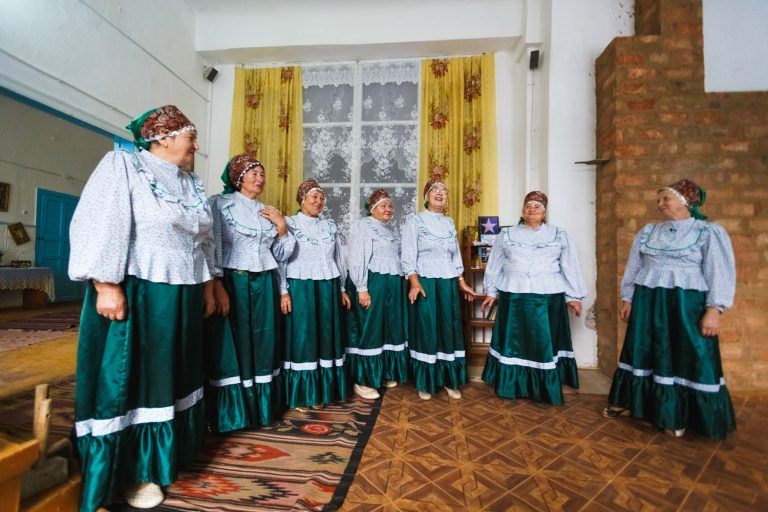
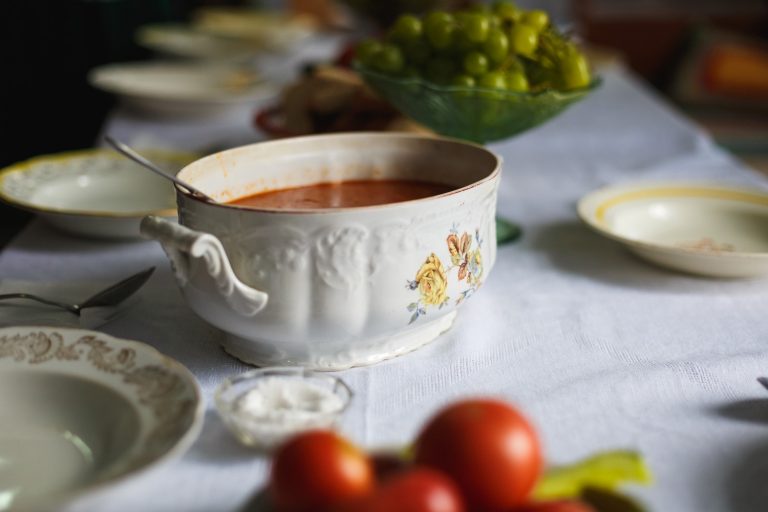
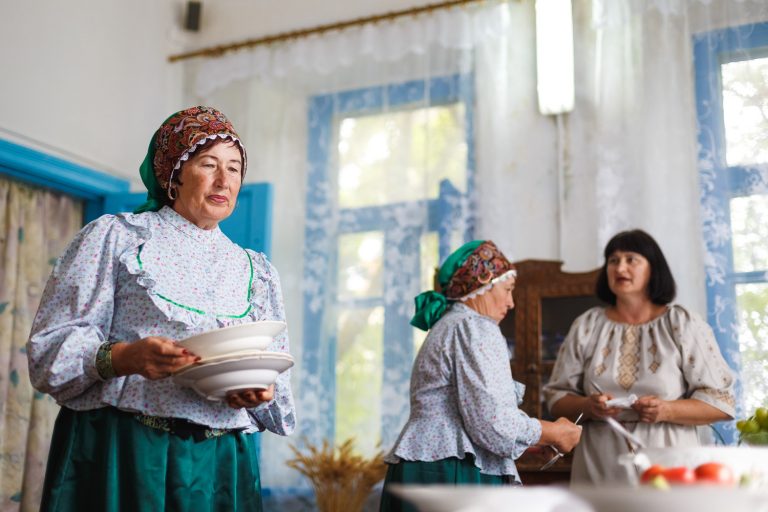
slideshow
Soviet authorities banned one of the most important parts of the Molokans’ spiritual life — the assembly. Every Sunday they met in the house of prayer twice a day, and read the Scriptures together and sang psalms. And although their meeting place did not resemble a traditional church with domes and icons, and their religion rejected the rites of baptism and communion, the Molokans felt threatened, so they secretly gathered in their homes. According to Liubov Fefelova, this greatly affected the next generation of Molokans.
— In Soviet times, we were not accustomed to it (meetings — ed.). Our parents still went to meetings, because my father was of 1908, and my mother was of 1913. But I was born in 1951, and we were the Soviet children already, we were going to pioneer camps. We were no longer accustomed to having those gatherings, everything was changing.
These days Sunday meetings have become a tradition in Novovasylivka. Only about 30 Molokans attend them, most of them elderly people, for whom this tradition has never been discontinued. There is also a Baptist church in the village, where several Molokans started to go. The main differences between the two spiritual communities are the rite of breaking the sacramental bread, or communion, which is followed by Baptists, unlike Molokans. Recently, a Greek Catholic church also opened in the village, and most of the Molokans born during the Soviet times choose the Orthodox Church, even though they are not baptised.
Tetiana Kutsova, like Liubov Fefelova, has never attended spiritual meetings of Molokan Christians, so she will not be able to pass this tradition on to the next generation. Instead, in 2006, a few Molokans, and Tetiana among them, founded the Rus Cultural Society, with the aim of reviving Molokan traditions, promoting their culture, and passing it on to the children. Tetiana became the head of the Society.

Russian House
Some time later, other residents of Novovasylivka joined the Society. Together they decided to create a museum, where they collected everything about the history of the village and Molokan culture. An old house was used for the museum, built in 1864 by a local industrialist Kalmykov, who owned a mill with gas engines. Tetiana recounts how they saved that building of historical significance from destruction:
— This house was originally built to hold meetings of the Molokan youth. Young people aged 18–25 were coming there for worship. When the village council decided to demolish the building and sell it for building materials, we turned to them with a request to lease it. That’s how we decided to open a museum there.

In the renovated building, fellow villagers brought some household items that were used by their ancestors. In addition to those, they also brought some works of art. There were enough paintings of the local artists to open an exhibition. This is how Russian House — a Museum of everyday life of the first settlers — appeared in Novovasylivka.
— Here we have not only paintings, there are also works of graphics, and embroidery, and Petrykivka art. Our fellow villager Serhii Symonov graduated from the school of folk crafts in the village of Petrykivka. And now he teaches painting our Molokan children.
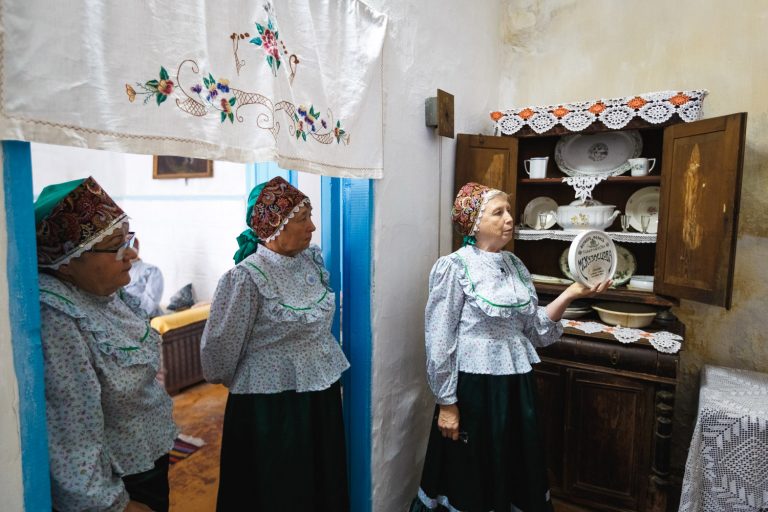
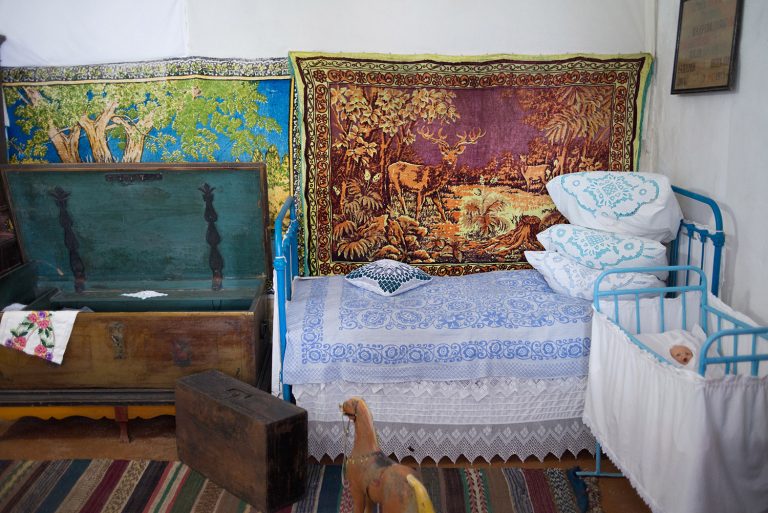
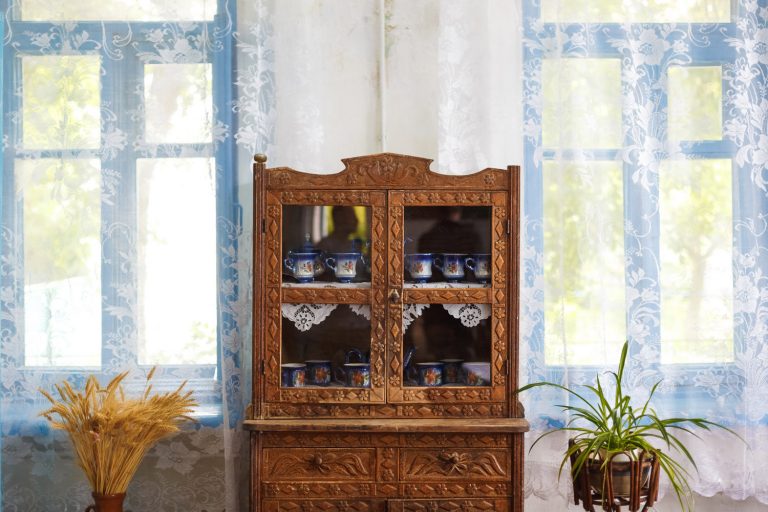
slideshow
The walls are covered with paintings of the former headmaster and teachers of the local art school. The museum often organises exhibitions for students, including the local school Harmony, which Molokans are very proud of. They have long since paid special attention to education. Everyone learned to write and read with the help of the Bible. That is why as soon as the houses were built in the village the school was built next.
Behind the exhibition hall the most interactive room in the museum is located — the Grandmother’s Room. Before entering it, Tetiana approaches the children with a linguistic question:
— What is the diminutive and affectionate form of the word ‘komnata’ (a ‘room’ — tr.) Well, they usually reply ‘kómnatka’. So I comment, “And the Molokans say ‘komnátka’.
The oldest generation was always provided with a cozy, quiet room at the end of the house, away from domestic noise and loud celebrations. Grandma’s bed had a duvet, a few large pillows, and a small pillow (a small pillow to put under her cheek). The children spent a lot of time in their grandmother’s room, so in the big wooden box there were always some candies or lumps of sugar.
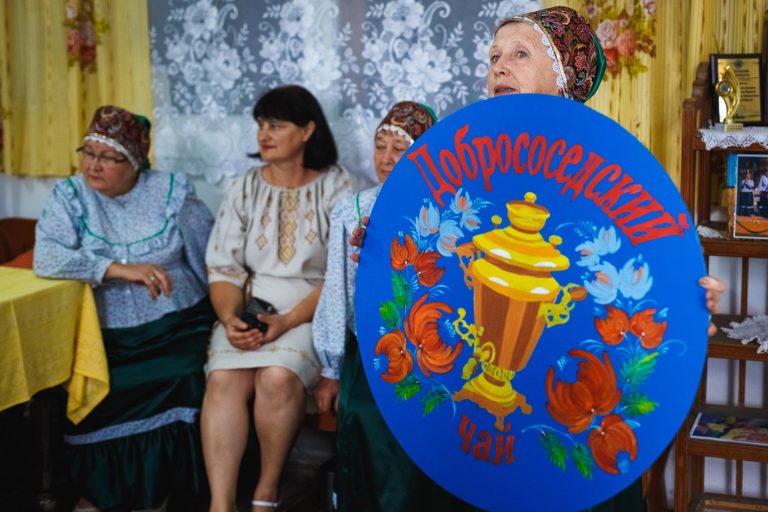
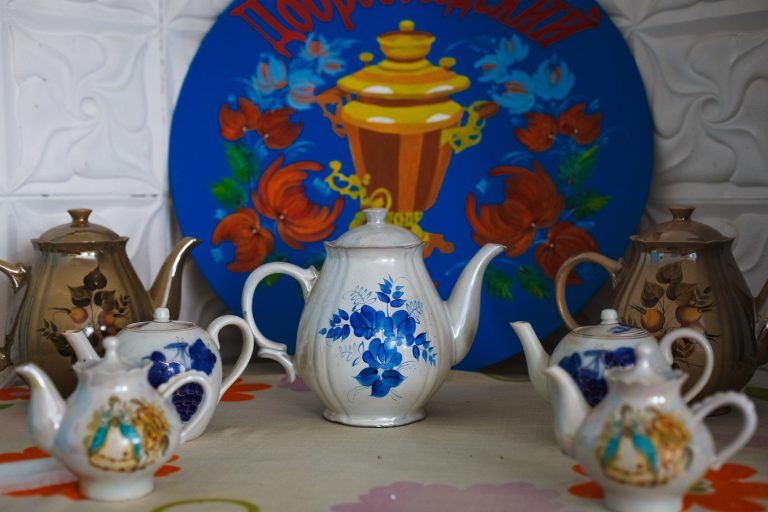
slideshow
Good-Neighbourly Tea
In the last hall of the museum there is always a delicious smell and a cheerful song. This is where the guests are received. Molokans have good relationships with the residents of neighbouring multinational villages, which include Bulgarians, Albanians and Greeks, and often invite neighbours to warm meetings with a cup of tea. Traditional get-togethers turned into the Good Neighbour Tea Festival, which has been organised for six years in a row.
– Various national-cultural societies from different parts of the Pryazovia territory, come to visit us. We collect the tea ingredients together. Albanians bring dried marigold flowers, Bulgarians bring tea roses, we dry camomile flowers and linden — and all these components make our tea. We brew it all year long: in the summer, and in winter. We all get together, enjoy our tea and have fun. We sing Bulgarian songs, dance a horo (a national Bulgarian dance-horovod. — ed.), and converse with Moldovans and Albanians.

Molokan tea drinking cannot be imagined without their traditional delicacies: thin pancakes and crumbled crumpets. Molokans call thin pancakes made with milk ‘blintsy’. Molokan cooks know that with one litre of milk no less than 53 pancakes can be made, and those who manage to make 64 thin pancakes reach true mastery. After the pancakes are fried in a pan, they are stacked one on another, covered with sour cream and then sent to the oven.
“Round as the sun” crumbled crumpets are cooked with kefir and also fried in a pan.
— While they are hot, you need to quickly crumble them into pieces of different sizes and put them in a ceramic bowl, with the butter at the bottom of it. Crumpets are arranged in layers, and from the top, they are soaked with homemade sour cream. They are so soft, airy, delicious, you won’t be pulled away without a fight!
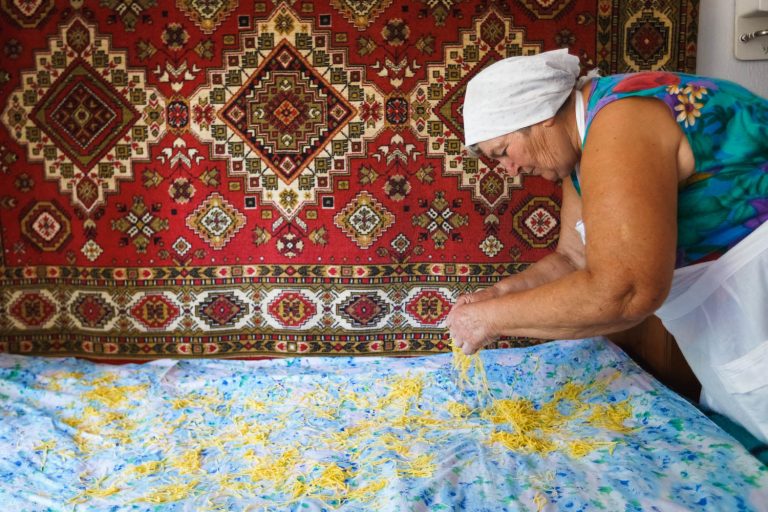

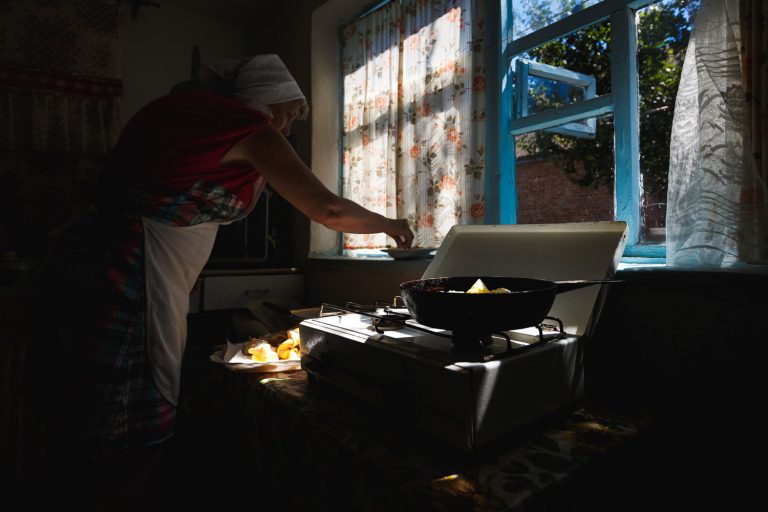
slideshow
Molokan Noodles
Molokans love homemade noodles more than anything. Women of Novovasylivka make it with eggs and flour, without salt and water. The main secret of Molokan noodles is not in the ingredients, but in the making process itself, which has been preserved in the village since olden times.
— You’ll need at hand a rolling pin, a board, a knife. I always know who can help me. Helpers bring eggs, some flour, and then get to work. Usually the dough was kneaded by the oldest woman, who had the most experience. So while one person kneaded the dough, the others would be rolling it out.
The ideal thickness of the rolled dough was checked on a tablecloth. If you could see the ornament of the tablecloth through the dough, then it was ready for the next stage. Then the dough should be folded in many layers and cut into thin strips, and then dried. Noodles are served with meat. Molokans prefer poultry because their religion does not allow them to eat pork.

From the same dough as the noodles, the Molokans make cuttings — sweet rings sprinkled with powdered sugar. The preparation of the dough has long been a test for future wives:
— People would bring their unmarried daughter or daughter-in-law, and the old women would judge how the girl handled and rolled the dough. Then, during their meal they all would discuss her skills.
Thanks to the active civic position of the Molokan women of Pryazovia, their dishes became a symbol of good deeds and support. During the first years of the war with Russia in eastern Ukraine, columns of Ukrainian servicemen were passing through Novovasylivka on their way to the front. Liubov recalls how she along with her friends tried to provide the support to the men:
— We took all actions we could: collected food, clothes, baked up to 600 pies a day. When our Dnipropetrovsk artillerymen were here, we were collecting food for them.
Without external help Molokan women organise various charity events. For the fourth year in a row, on the first day of Shrovetide, women hold a charity event. They cook their famous pancakes and go to the hospital to greet everyone with the arrival of spring. They hope to believe that in this way they revive the old Slavic custom:
— The first pancake was given to little birds and to those in need: the poor, the orphans, the disabled.
Harvest Day is also celebrated in Novovasylivka. Fellow villagers decorate the area around the Russian House, and prepare the hall for a charity dinner. Everyone comes to treat themselves to noodles and borshch. In the afternoon, activists deliver food to the needy.

Psalms singing. Bird of Paradise
One of the ancient Molokan traditions is the singing of psalms. The performance of such works is considered to be one of the most difficult, partially because they have never been recorded or sung on notes. The older generation passed the psalms on from their memory to the younger one up until the times of the Soviet Union. Liubov Fefelova regrets that, as a child, she did not inherit this knowledge from her mother. She learned to sing psalms many years later, when she began singing in the Bird of Paradise ensemble.
Psalms
Lyrical prayer songs performed during festivals, ceremonies and commemorations of tragic events.— We were writing the psalms down on an A4 sheet, line after line, marking sounds: here is a dot, here is a dash, here is an exclamation mark, here we should sustain a note, there we should not. But then the old people would sit down and sing in a completely different way. Ka-ra-ul! But so, little by little, we got used to one another and they began teaching us psalms and the old Molokan songs.
The ensemble was formed in 2008 by the members of the Rus Society, and named after the song of the same name, which became their major trademark.
After learning the old Molokan songs and psalms, the “Birds” began to attend local and international festivals. The greatest pride for them was the participation in the international folklore festival Trinity Round Dances in 2011 in the Orel region of Russia, where they represented Ukraine.
In addition to spiritual songs, the ensemble sings Ukrainian and Russian folk songs. The repertoire even includes bilingual songs, where one verse is sung in Ukrainian and the other — in Russian.

With the beginning of the Russian–Ukrainian war, the ensemble stopped traveling to Russia, although they were invited to a folklore festival again. They often travel across Pryazovia and sing along with the representatives of other national minorities of the region. They sing Bulgarian songs with Bulgarians, and Moldavian songs with Moldovans. Now the ensemble is headed by Liubov Fefelova, who comes from a multinational family.
— Our eldest son-in-law was a Bulgarian, my daughter-in-law was a Molokan, then we have a member of our family who is a Rostov Cossack from Semibalki, Rostov region, my husband is an Azov Greek, and my younger sister’s husband is from the Ural region in Russia.
Molokans of Novovasylivka rejoice at such an ethnic diversity of the region and consider Ukraine as their Homeland. Their Ukraine is Novovasylivka.

